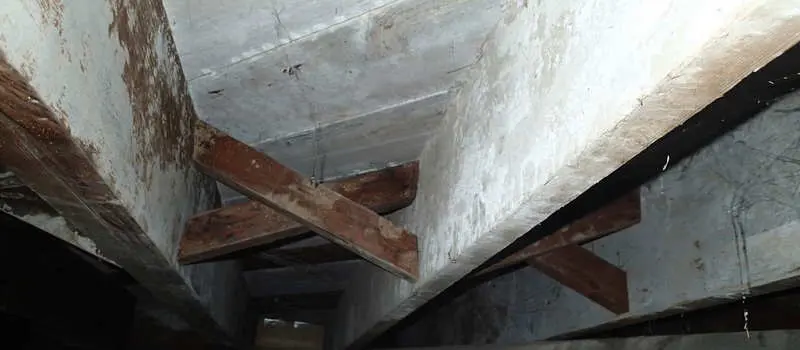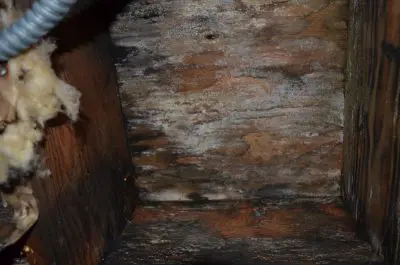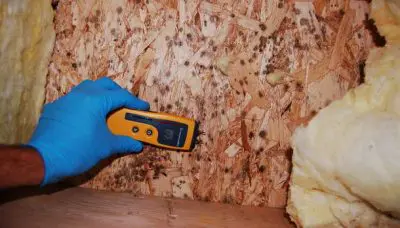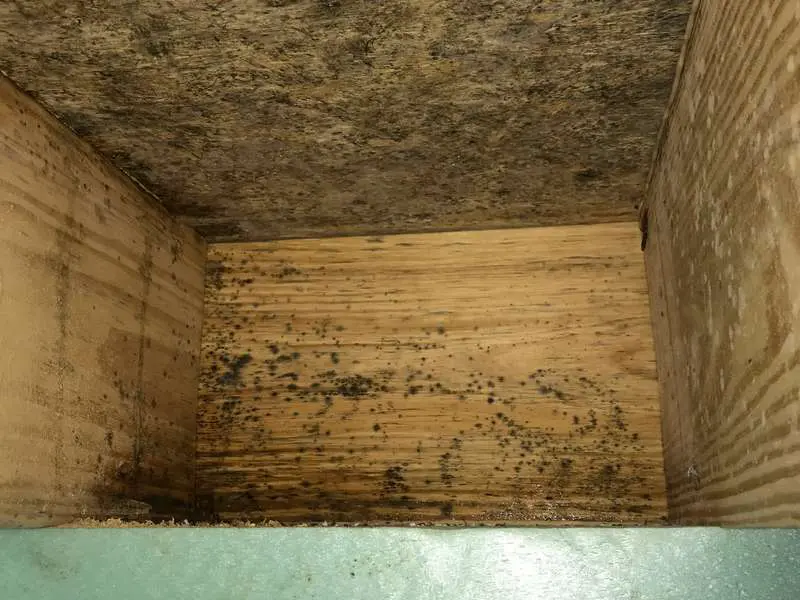Crawl Space Mold Causes & Solutions
First, is it really mold growth?
Before any remediation is performed, you must determine whether you’re really dealing with mold. Thankfully, this rarely requires testing. A trained professional should be able to easily distinguish between mold growth and other substances.
Possible false alarms
Concrete can look surprisingly like white mold growth. In the past, the same wood used for the concrete foundation forms were re-purposed as material for the subfloor. You’ll also find this on attic sheathing. It’s pretty easy to differentiate between the two. Scrap it with a screwdriver. If it’s concrete, it won’t budge. If it’s mold, it will easily scrape away (though some staining may remain embedded in the surface).
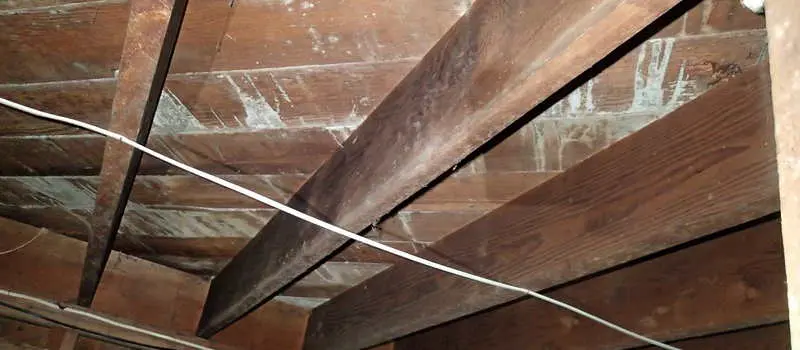
Concrete residue masquerading as mold growth
Examples of mold growth
While concrete may create some confusion, mold growth in a crawl space is typically easy to recognize. In most cases, the mold will appear in a round, speckled growth pattern. You’re unlikely to see the uniform, black appearance as is common in attics. As the growth intensifies it expands in a 3-dimensional pattern.
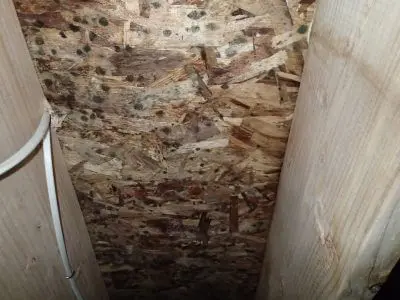
Light / moderate mold growth on the subfloor – typically due to saturation during the original construction.
Unusual cases
Under rare circumstances, fungal growth can occur at quite impressive levels. This amount of growth requires continuous, heavy saturation and a bit of bad luck. The regular types of mold you find in a crawl space (i.e. cladosporium) will not produce this kind of growth. Only a handful of species of fungi are capable of producing this result. Unlike traditional molds, this type of fungal growth can destroy the structural integrity of the framing. In this particular case, many of the joists required replacement.
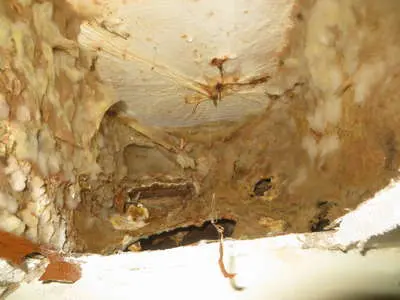
Heavy fungal growth. Major structural damage is likely present.
Is the mold actively growing?
The next question is whether the mold growth is from a current problem or a prior issue. Mold growth does not fade with time, which can make it tricky to determine the timeline of an issue. An issue from 20 years ago can look the exact same as something from 2 months ago.
Use a moisture meter
Test the moisture content of the subfloor and adjacent joists/beams. Anything above 20% moisture content is suspicious and warrants further investigation. Check the entire crawl space – is the moisture confined to a limited area or systemic throughout the sub floor? If it’s in a limited area, check whether for local plumbing issues.
What if it’s <20%?
While a >20% result likely points to a current issue, a dry result (<20%) does not prove it’s an old/former problem. This is because mold growth due to condensation can occur at levels undetected by a moisture meter. Light to moderate growth my occur due to elevated moisture on the very surface of the wood. This thin layer of moisture will not show up with a moisture meter.
Further proof – check behind the insulation
If the subfloor is insulated (or was until recently) AND there’s mold growth on the subfloor, you’re likely looking at growth from the original construction of the home. Moisture from ongoing issues such as a missing vapor barrier or insufficient crawl space vents will not migrate past the insulation. Therefore, if mold is behind the insulation, you have pretty strong proof this is not an ongoing problem. Like many homes, the subfloor was likely saturated by rainwater during construction which led to mold growth on the subfloor.
Next, identify the cause of the growth
- Saturation from rain during the original build out
- Missing vapor barrier
- Poor ventilation (in certain climates)
- Water leak from above
Mold growth from the original construction
A common scenario in wet climates such as the Pacific Northwest. Houses built during the winter months can develop systemic mold problems if not dried correctly. Dryout does not necessarily require dehumidifiers or heaters; often simple air movers and blowers can address the problem. Unfortunately, even the most basic dry out techniques are not implemented by contractors. This leaves a crawlspace full of saturated lumber trapped above saturated soil; essentially a very large petri dish experiment.
Saturation occurs in two ways:
- Direct contact with rainwater and
- Secondary saturation due to moisture released from adjacent saturated materials, such as ground soil, concrete foundation, etc.

Mold Growth in Crawlspace
Mold growth due to missing vapor barrier:
Primarily an issue in cool climates, missing vapor barriers contribute to the moisture load throughout the entire crawlspace. Additionally, a missing vapor barrier can have a significant impact on the moisture load in the conditioned air space above. The physics behind the problem is pretty simple. If you recall from your high school science class, diffusion describes the movement of particles from areas of higher concentration to areas of lower concentration. In the case of a missing vapor barrier, the concentration of water molecules in the soil is higher than the air, causing the moisture to migrate upward.
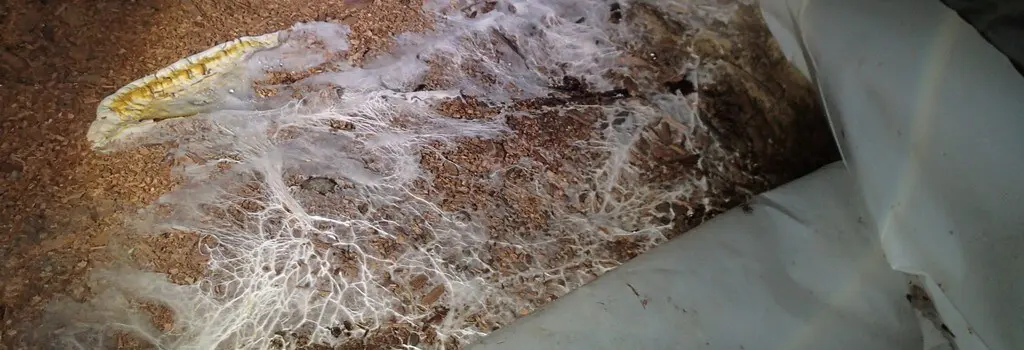
Mold on Soil in Crawlspace
This particular crawlspace had a vapor barrier, though a previous contractor had shoved it off to the side. Microbial growth on the soil won’t affect the structural integrity of the building, but it can have a profound effect on the indoor air quality. The severity of the issues depends primarily on the dampness of the soil. Some homes, especially those near the top of a hill, may have very dry soil and suffer few ill effects from a missing vapor barrier. Most homes, however, encounter periodic dampness throughout the rainy season, necessitating a well-installed vapor barrier.
Crawl space flooding
A vapor barrier doesn’t do much good when the water is floating on top of it… In reality, though, periodic crawlspace flooding typically doesn’t cause significant mold problems. An exception should be made for hot/humid climates where the additional moisture load could lead to condensation on the underside of the floor assembly during cooling months.
- Elevated water table
- Improperly installed gutters and downspouts
- Periodic surface flooding
- Rainwater during initial construction
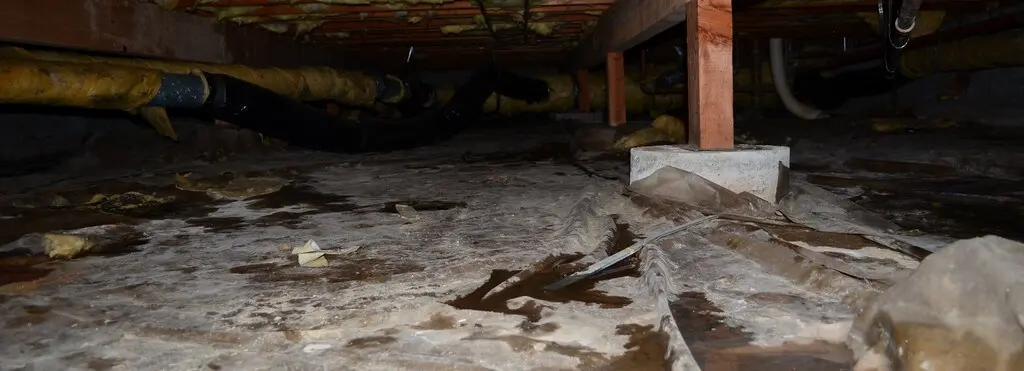
Crawlspace Flooding
Crawl space as a storage unit?
Never a good idea. The only exceptions I’ve found to this rule are conditioned crawlspaces with a concrete slab. In a normal crawlspace, you’ll assuredly infuse everything you store with a musty odor. In a problem crawl space, you’ll find your contents covered with mold growth and rodent droppings.
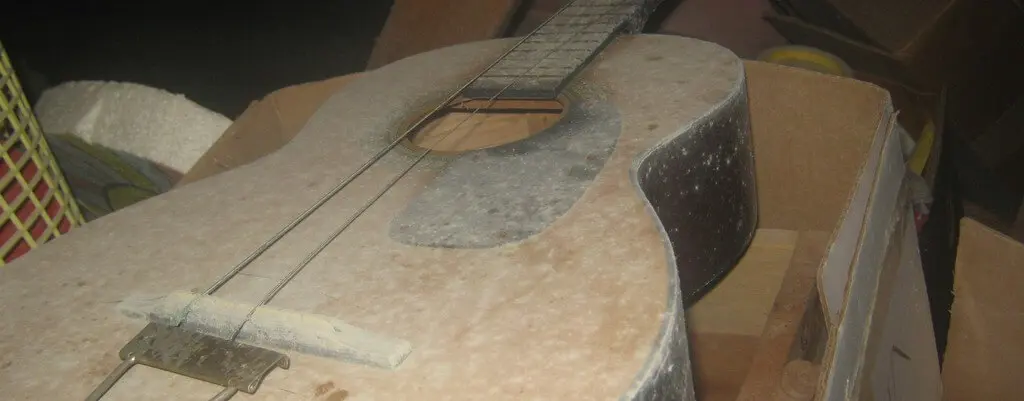
Mold on Contents
Mold growth due to water leaks from above
Where does water go when a pipe leaks or a toilet seal fails? If it occurs on the first floor of a home – directly into the crawlspace. Of course, most people don’t want to enter a crawl space, so the moisture buildup often goes undetected. Bathroom issues are the most common culprit. Catastrophic incidents such as burst pipes wreak such havoc that the entire home is investigated. Leaks from a toilet seal or shower pan are typically slow and can remain undetected for months. Once the first sign of an issue is observed, extensive damage has often already occurred.
The photo below is a shower with the tile, pan and subfloor removed. Much of the framing had completely lost its structural integrity.
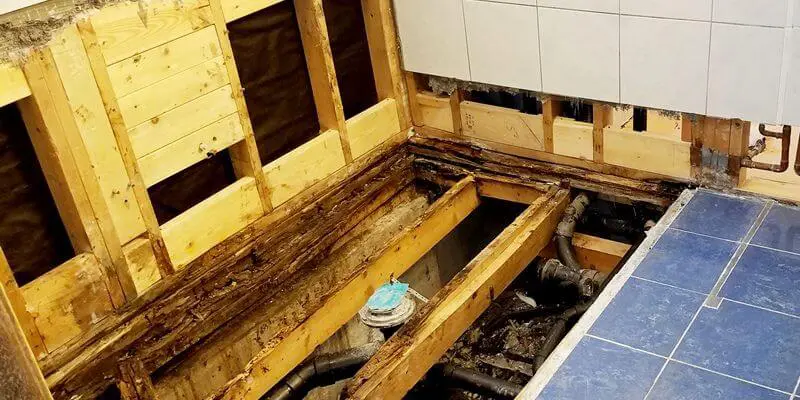
Heavy rot and mold in crawl space.
FAQs
Should I test the air in my crawl space?
No. Air testing for mold should only be performed in the conditioned part of the home. Testing in the crawlspace (or attic) is of little value. These spaces have direct ventilation with the outside air and therefore your testing results will offer no insight into the condition of your crawl space.
Has the mold affected the structural integrity of the framing?
The type of mold growth typically found in a crawl space will not affect the strength of the framing. However, extended saturation can lead to other fungal growth (such as dry rot, brown rot, etc.) which can certainly degrade the framing. This type of fungal growth requires much higher levels of moisture than mold.
How common is mold on crawlspace insulation?
Mold on the insulation is quite rare. Occasionally it will occur in small areas due to a burst pipe or standing water.
Project Report > Inspection for Crawlspace Issues
PROPERTY DESCRIPTION:
- Total of 4,140 sq ft.
- Single Family Residence built in 1991
LOCATION: Back Bathroom
Observations:
- Rear portion of home had been flooded by a recently built retention pond behind the home.
- Water damage was noted around the bottom 2-3 ft of sheetrock of the entire bathroom.
- Minor mold growth was noted on the surface of the sheetrock along exterior wall primarily.
- All baseboard trim was stained and water damaged.
- Shower appeared to have had some moisture run under fiberglass pan. This should be able to be cleaned / treated via opening the walls on either side of the shower.
- Water damage was also noted in the ceiling and wall of the stall where the toilet was located. No elevated moisture levels were noted at this time however, significant bubbling of paint and drywall tape were noted.
- Carpeting leading out of bathroom requires removal.
- Visible mold growth was also noted on contents located behind bathroom door.
- Linen chest near door exhibited some visible mold growth and will need cleaning.
- Vanity cabinet showed significant signs of water damage along the bottom edges and should be removed and disposed of. Counter top and sink are in good condition and can be salvaged.
- RH:48 % Temp: 60°F CO2: 518 ppm CO: 0 ppm
Recommendations:
- Shower does not require removal at this point.
LOCATION: Crawlspace
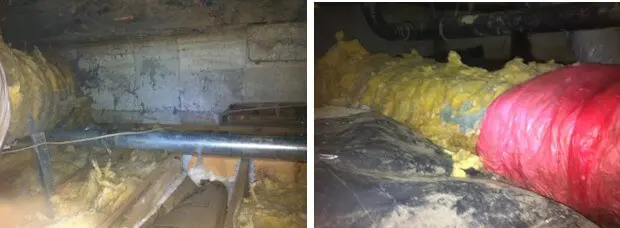
Crawlspace Ducting Issues
Observations:
- Good vapor barrier found throughout crawlspace.
- Some pieces of insulation have fallen down due to missing or infrequent wire securing rods.
- HVAC ducts did not appear to be sealed and allowed conditioned air to enter the crawlspace.
- Many locations were noted where ductwork was not insulated.
- Main HVAC trunk line did not appear to be suppored adequately and allowed contact with the ground. This has resulted in insulation contacting standing water that occasionally infiltrates the crawlspace. Visible mold growth was noted on the insulation at this time.
- Evidence of rodent intrusion existed throughout the crawlspace. Insulation on HVAC ducting appears to be contaminated by rodent feces and urine and should be removed and replaced.
- Sump pump was present in crawlspace and appeared to be functioning well.
- Drain from sump pump ties into exterior downspout drain and appears to spill water onto the concrete sidewalk whenever it operates.
Recommendations:
- Recommend having an HVAC contractor remove all HVAC insulation and seal all metal ductwork with high flow duct sealant.
- Recommend supporting all ductwork to ensure it does not contact the ground.
- Recommend having exterior downspout evaluated and repaired to prevent overflowing to occur from sump pump.
*Heads up – I earn a small commission on sales through Amazon links. This helps cover the expense of running the website (and answering your questions!)
Got a question? Ask it here and we'll post the answer below
We have a new addition-not even insulated yet. Our builder had our crawl closed for a period of time and then didn’t communicate with us how wet it was. We now have mold. I assume we need it remediated? Do we need to have all surfaces cleaned or can we just clean the wood parts? I’ve had two companies give us estimates and one said they would just treat the wood and the other said they would treat all... I don’t want to be taken advantage of but I also want it taken care of properly.
I recommend focusing the treatment on the area of visible mold growth. The mold growth will stop as soon as the wood dries out (<20% moisture content).

